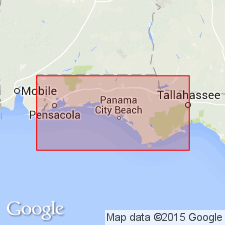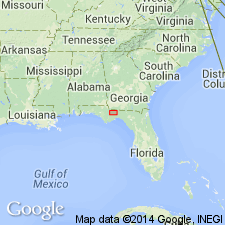
- Usage in publication:
-
- St. Marks facies
- Modifications:
-
- Original reference
- Dominant lithology:
-
- Limestone
- AAPG geologic province:
-
- South Georgia sedimentary province
Summary:
Pg. 16 (table 1), 20-21. St. Marks facies in Tampa stage. Name St. Marks limestone (type locality, Wakulla County, Florida Panhandle) was originally used by Finch (1823, Amer. Jour. Sci., v. 7, p. 31-43) in describing the occurrence of large oysters. Name St. Marks revived to include calcareous downdip facies of Tampa stage. Near Tampa, facies consists of basal light-gray to yellow limestone of which "Silex bed" is a part. Upper part conists of greenish clay with calcareous nodules. Estimated thickness in subsurface 65 feet. Updip facies named Chattahoochee facies. [Finch, 1823 [1824], described a limestone at St. Marks, Florida, but did not use term St. Marks limestone.]
Source: US geologic names lexicon (USGS Bull. 1200, p. 3398).

- Usage in publication:
-
- St. Marks Formation
- Modifications:
-
- Overview
- AAPG geologic province:
-
- South Georgia sedimentary province
Summary:
Unit originally assigned to the Tampa Stage as a facies by Puri (1953). The St. Marks includes the offshore, calcareous, downdip facies of the lower Miocene. Gadsden Co. is a transitional area where the calcareous St. Marks on the east and south interfingers with the more siliciclastic and dolomitic Chattahoochee Formation in the west. In much of central and eastern Gadsden Co., these two facies interfinger. The St. Marks is typically white to very light gray, fossiliferous, micritic limestone. May contain minor amounts of clay and quartz sand. Most abundant fossils are mollusk molds and benthic Foraminifera.
Source: GNU records (USGS DDS-6; Reston GNULEX).
For more information, please contact Nancy Stamm, Geologic Names Committee Secretary.
Asterisk (*) indicates published by U.S. Geological Survey authors.
"No current usage" (†) implies that a name has been abandoned or has fallen into disuse. Former usage and, if known, replacement name given in parentheses ( ).
Slash (/) indicates name conflicts with nomenclatural guidelines (CSN, 1933; ACSN, 1961, 1970; NACSN, 1983, 2005, 2021). May be explained within brackets ([ ]).

